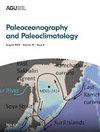东赤道太平洋始新世-渐新世过渡期的瞬态深海冷却
IF 3.2
2区 地球科学
Q2 GEOSCIENCES, MULTIDISCIPLINARY
引用次数: 0
摘要
在大约3400万年前的始新世-渐新世过渡期(EOT),地球突然转变为一种足够凉爽的气候状态,使南极洲在数千万至数亿年内首次维持大型冰盖。深海海底有孔虫(δ18Ob)的氧同位素记录为我们理解新生代气候史上的这一转折点提供了基础。然而,由于缺乏独立的深海温度重建,以及对δ18Ob记录中的温度和大陆冰体积信号进行去卷积的持续挑战,更深入的了解受到了阻碍。在这里,我们使用聚集同位素测温法为EOT提供了赤道太平洋东部深海温度变化的记录,这允许独立于海水化学和大陆冰体积的明确温度重建。我们的记录表明,太平洋深处在EOT显著冷却了4.7±0.9°C。这一温度下降代表了与新生代主要冰川作用开始相关的深海冷却的第一个直接而有力的证据。然而,我们的数据也表明,在EOT时,太平洋深处的这种主要冷却是短暂的(~200千里),温度在33.6 Ma时反弹到接近EOT前的水平。我们计算的海水δ18O记录表明,尽管持续存在大规模南极冰盖,但海洋温度还是出现了这种反弹。这一发现表明,赤道太平洋东部的深海温度与新建立的南极冰盖的行为之间存在一定程度的脱钩。本文章由计算机程序翻译,如有差异,请以英文原文为准。
Transient Deep Ocean Cooling in the Eastern Equatorial Pacific Ocean at the Eocene‐Oligocene Transition
At the Eocene‐Oligocene Transition (EOT), approximately 34 million years ago, Earth abruptly transitioned to a climate state sufficiently cool for Antarctica to sustain large ice sheets for the first time in tens to hundreds of millions of years. Oxygen isotope records from deep‐sea benthic foraminifera (δ18Ob) provide the foundation of our understanding of this pivot point in Cenozoic climate history. A deeper insight, however, is hindered by the paucity of independent deep‐sea temperature reconstructions and the ongoing challenge of deconvolving the temperature and continental ice volume signals embedded in δ18Ob records. Here we present records of deep‐sea temperature change from the eastern equatorial Pacific for the EOT using clumped isotope thermometry, which permits explicit temperature reconstructions independent of seawater chemistry and continental ice volume. Our records suggest that the deep Pacific Ocean cooled markedly at the EOT by 4.7 ± 0.9°C. This decrease in temperature represents the first direct and robust evidence of deep‐sea cooling associated with the inception of major Cenozoic glaciation. However, our data also indicate that this major cooling of the deep Pacific Ocean at the EOT was short‐lived (∼200 kyrs), with temperatures rebounding to values close to pre‐EOT levels by 33.6 Ma. Our calculated record of seawater δ18O suggests that this rebound in ocean temperature occurred despite the continued presence of a large‐scale Antarctic ice sheet. This finding suggests a degree of decoupling between deep ocean temperatures in the eastern equatorial Pacific Ocean and the behavior of the newly established Antarctic ice sheet.
求助全文
通过发布文献求助,成功后即可免费获取论文全文。
去求助
来源期刊

Paleoceanography and Paleoclimatology
Earth and Planetary Sciences-Atmospheric Science
CiteScore
6.20
自引率
11.40%
发文量
107
期刊介绍:
Paleoceanography and Paleoclimatology (PALO) publishes papers dealing with records of past environments, biota and climate. Understanding of the Earth system as it was in the past requires the employment of a wide range of approaches including marine and lacustrine sedimentology and speleothems; ice sheet formation and flow; stable isotope, trace element, and organic geochemistry; paleontology and molecular paleontology; evolutionary processes; mineralization in organisms; understanding tree-ring formation; seismic stratigraphy; physical, chemical, and biological oceanography; geochemical, climate and earth system modeling, and many others. The scope of this journal is regional to global, rather than local, and includes studies of any geologic age (Precambrian to Quaternary, including modern analogs). Within this framework, papers on the following topics are to be included: chronology, stratigraphy (where relevant to correlation of paleoceanographic events), paleoreconstructions, paleoceanographic modeling, paleocirculation (deep, intermediate, and shallow), paleoclimatology (e.g., paleowinds and cryosphere history), global sediment and geochemical cycles, anoxia, sea level changes and effects, relations between biotic evolution and paleoceanography, biotic crises, paleobiology (e.g., ecology of “microfossils” used in paleoceanography), techniques and approaches in paleoceanographic inferences, and modern paleoceanographic analogs, and quantitative and integrative analysis of coupled ocean-atmosphere-biosphere processes. Paleoceanographic and Paleoclimate studies enable us to use the past in order to gain information on possible future climatic and biotic developments: the past is the key to the future, just as much and maybe more than the present is the key to the past.
 求助内容:
求助内容: 应助结果提醒方式:
应助结果提醒方式:


